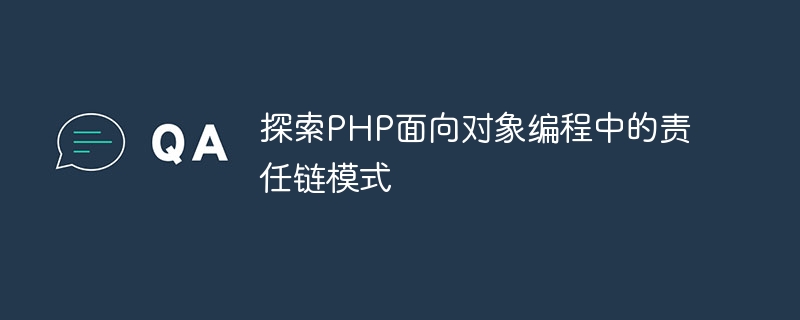

Explore the chain of responsibility pattern in PHP object-oriented programming
The chain of responsibility pattern is a behavioral design pattern that allows requests to be passed along the processing chain until until a handler is able to handle the request. This enables decoupling between different processors and allows dynamically changing the processing chain or adding new processors.
In PHP, the chain of responsibility pattern can be better implemented using object-oriented programming. Below we will illustrate with a sample code.
First, we create an abstract class Handler as the base class of the handler, which contains a method handle() for processing requests and a method setNext() for setting the next handler:
abstract class Handler
{
protected $nextHandler;
public function setNext(Handler $handler)
{
$this->nextHandler = $handler;
}
abstract public function handle(Request $request);
}Then, we create a specific handler class, inherit from Handler, and implement the handle() method. The specific processing logic is completed in this method. If the current handler cannot handle the request, it passes the request to the next handler. The following is a concrete sample code:
class ConcreteHandler1 extends Handler
{
public function handle(Request $request)
{
if ($request->getType() == 'type1') {
echo "Handled by ConcreteHandler1
";
} else {
if ($this->nextHandler) {
$this->nextHandler->handle($request);
} else {
echo "No handler can handle the request
";
}
}
}
}Next, we create another concrete handler class ConcreteHandler2. Its processing logic is different from ConcreteHandler1. We set it as the next handler of ConcreteHandler1:
class ConcreteHandler2 extends Handler
{
public function handle(Request $request)
{
if ($request->getType() == 'type2') {
echo "Handled by ConcreteHandler2
";
} else {
if ($this->nextHandler) {
$this->nextHandler->handle($request);
} else {
echo "No handler can handle the request
";
}
}
}
}Finally, we create a Request class to encapsulate the requested information. This makes it easy to pass requests between different handlers:
class Request
{
protected $type;
public function __construct($type)
{
$this->type = $type;
}
public function getType()
{
return $this->type;
}
}Now, let’s test how the chain of responsibility pattern works. We first create a request object, then create two handler objects and set up the processing chain between them. Finally, we pass the request to the first handler and see if we can find a handler that can handle the request. The following is the test code:
$request = new Request('type2');
$handler1 = new ConcreteHandler1();
$handler2 = new ConcreteHandler2();
$handler1->setNext($handler2);
$handler1->handle($request);Run the above code, the output result is:
Handled by ConcreteHandler2
Through the test code, we can see that when the request type is' When type2', ConcreteHandler2 can handle the request, so "Handled by ConcreteHandler2" is output; when the request type is 'type1', ConcreteHandler1 cannot handle it, so the request is passed to the next handler, ConcreteHandler2. If there is no next handler in the processing chain, "No handler can handle the request" is output.
The chain of responsibility model provides us with a flexible method of processing requests. The processing logic of the processor can be designed according to the actual business scenario, and the processing chain can be easily expanded and modified.
To sum up, through object-oriented programming, we can better implement the chain of responsibility model in PHP. In the process of processing requests, each processor only needs to pay attention to the requests that it can handle. If it cannot handle it, the request will be passed to the next processor. This enables decoupled and dynamic processing chains. Through sample code, we can better understand and use the chain of responsibility pattern and improve the maintainability and flexibility of the code.
References:
The above is the detailed content of Explore the chain of responsibility pattern in PHP object-oriented programming. For more information, please follow other related articles on the PHP Chinese website!